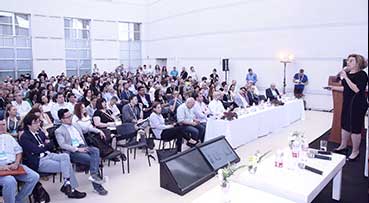In the fast-paced transition to hybrid work, many organizations find themselves lacking a well-defined policy, and the impact on their results is becoming evident. With the majority of us venturing into this new work model without proper planning or intention, we have simply blended the traditional office and remote work without strategic decisions. Consequently, we have created suboptimal work environments that fail to equip employees, managers, and leadership with the necessary tools for success. Adding to the complexity, the ongoing public debate surrounding remote work versus office work further clouds the path forward. As a result, numerous organizations are waiting on the sidelines, hoping for the dust to settle before determining their winning work approach.
However, it is crucial to recognize that today’s hybrid work, characterized by a division between home and office days, is merely a transitional phase toward a new work paradigm. Engaging in debates solely about the number of office days required hinders us from engaging in the truly important conversation about the emerging opportunities and changes within the new work landscape.
To gain a clearer perspective, let’s take a leap forward to 2030, where the workspace will bear little resemblance to the hybrid work we currently define. The future of work will be a dynamic network of physical and virtual offices, available on-demand at any time and from any place. Work will no longer be confined to a specific location; it will be an activity we engage in. At one end of this transformed workspace, traditional office buildings will continue to serve as spaces for specific tasks and potentially act as cultural anchors, guiding values, goals, and purpose. However, relying solely on physical structures is no longer sufficient. The other end of the work spectrum is the digital space—the online office. Advancements in technology will enable collaborative work without the constraints of time or physical presence. While we are familiar with some of these tools, such as video meetings that simulate presence, future digital workspaces will offer enhanced experiences, stimulating multiple senses and optimizing collaboration even across different times and locations. The younger generation within your organization is already accustomed to these virtual work dynamics through collaborative gaming experiences, where they create virtual worlds, form relationships, and develop skills, inadvertently preparing for work in the digital space.
Between these two extremes—physical and digital—lie shared spaces, locations accessible to different individuals at different times. This includes office spaces located within close proximity to homes, enabling a reimagining of work schedules and a blending of personal and professional lives. These offsite work solutions empower us to operate in diverse locations at various times, promoting asynchronous work that can be conducted independently without relying on real-time collaboration. However, embracing such flexibility requires the adoption of appropriate tools, knowledge management, streamlined processes, and training. Recognizing that traditional meetings, which were once deemed essential, are no longer effective in the evolving landscape, organizations must shift their focus towards leveraging “togetherness” in more impactful ways.
Looking ahead, a successful hybrid work policy must prepare organizations for work across the entire spectrum—embracing the diverse work solutions spanning physical spaces, collaborative environments, homes, and digital tools. It should facilitate seamless work, collaboration, coordination, management, innovation, and development without mandating office presence for all these activities.
The demise of the traditional office also marks the end of the old organizational structure. These conventional workplaces, characterized by physical boundaries and furnishings, symbolized an organization’s pursuit of certainty. They represented production lines for knowledge workers, emphasizing hierarchy and centralization. In the future of work, where operations extend across the entire workspace, attempts to centralize resources and control processes and decisions will clash with the inherent flexibility and unpredictable nature of the networked environment. Furthermore, the crucial element of “togetherness” must be learned and cultivated across the entire work spectrum. The ability to collaborate effectively and create a sense of presence, regardless of time and place, becomes paramount in hybrid work, which thrives on reduced certainty and increased flexibility.
Flexibility, however, comes at the cost of control, and this loss of control often evokes fear. We are accustomed to attempting to control work processes, focusing on attendance, meetings, presentations, and documents. Yet, these aspects do not truly capture the essence of work itself. They are merely ancillary tasks that revolve around work. The day we can measure, manage, and maximize the work itself—the core purpose for which organizations exist—we will know that we are focusing on the right priorities. While technology plays a crucial role in enabling an effective new work space, the most significant factor lies in building and managing trust. Without trust, it is impossible to thrive in a space where work is increasingly conducted without physical presence.
Therefore, approaching hybrid work policy solely based on employee demands or the need for flexibility is insufficient. Such an approach fails to address the fundamental challenge of measuring work itself and tackling the trust-related obstacles that impede the adoption of greater flexibility. Instead, it is essential to recognize that hybrid work is not merely a type of work; it is a paradigm encompassing multiple work environments. Thus, organizations must equip employees and managers alike with the skills and mindset required to navigate this diverse work landscape.
Now is the opportune time to engage in a meaningful dialogue regarding a comprehensive hybrid work policy. However, it is crucial to transcend discussions solely focused on temporary workspaces—offices and homes. A robust policy must encompass broader considerations, such as how work is conducted, communication protocols, tool utilization, availability expectations, collaborative activities, and areas where independent work is more suitable. It also presents an opportunity to reevaluate resource allocation and costs associated with physical offices, home offices, benefits, and conditions that may require adjustment. Additionally, new paradigms for talent acquisition and training must be developed to ensure that employees and managers are equipped with the necessary skills to excel in this evolving work landscape. It is important to anticipate mistakes, make adjustments, and strive for accuracy as the organization progresses on its hybrid work journey.
The good news is that the policy being created now is not set in stone. It will evolve and adapt alongside the organization’s learning and changing environment. By engaging in ongoing discourse, staying updated, and embracing change, organizations can continually refine their approach to hybrid work, finding a position that aligns with their unique needs. Moreover, this proactive stance positions organizations to shape the future rather than simply responding to it.
Embracing the power of hybrid work means understanding that the workspace of tomorrow extends beyond physical boundaries and rigid structures. It requires a strategic shift in mindset, a willingness to explore new possibilities, and a focus on trust-building and effective work management. By doing so, organizations can unlock the full potential of hybrid work, fostering innovation, collaboration, and success in the future of work.

![large-AX1A2125-2[1] large-AX1A2125-2[1]](https://niritcohen.com/wp-content/uploads/elementor/thumbs/large-AX1A2125-21-pnzedcs72atx5aeurqytqdiihxixlq02re9mlz805s.jpg)






